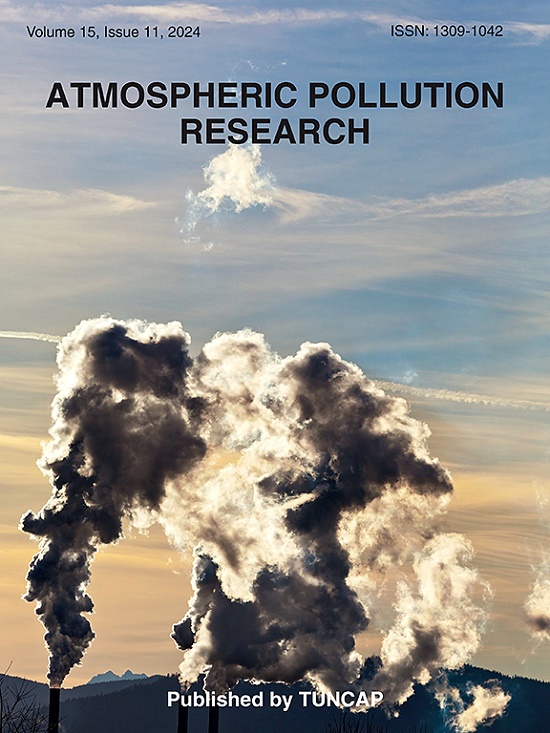Characteristics and sources of volatile organic compounds and their impacts on ozone formation in a coastal city of southeastern China
IF 3.5
3区 环境科学与生态学
Q2 ENVIRONMENTAL SCIENCES
引用次数: 0
Abstract
Ozone (O3) pollution is a severe environmental issue, highlighting the critical role of volatile organic compounds (VOCs), a precursor of O3, in urban air pollution control. In this study, we analyzed continuous hourly measurements of VOCs and O3 in 2022 in a coastal city of southeast China, Fuzhou, to characterize VOC seasonal variations and sources, as well as their contributions to O3 formation in the region. The results show that the annual mean concentrations of VOCs is 18.3 ± 10.4 ppbv, which is much lower than cities in northern and central China. According to the emission ratios, VOCs in Fuzhou are significantly impacted by liquefied petroleum gas and natural gas (LPG/NG) (30.6 %), but are less affected by vehicle exhaust emissions (20.9 %) than those in Chinese megacities, because of the consumption of clean energy increased to 30 % in Fuzhou. Seasonally, VOC sources exhibit a higher proportion of the solvent source in summer, driven by increased production from the agricultural fertilizers, integrated circuits, and beverage production. In autumn, the elevated industrial VOC emissions, including cement and petrochemical industries, contribute a high proportion of 23.1 % to the total VOC. The proportion of LPG/LPG source in winter is higher than in other seasons, mainly due to the growth in VOCs emissions and the increase in emissions from burning sources. The LPG/NG and vehicle exhaust source are the primary contributors to O3 formation potential (OFP) throughout the year, except in summer when vehicle and solvent emissions become the leading contributors to OFP. Finally, we identified multiple elevated O3 events associated with increases in VOCs. We conservatively estimate that on average of these events, a 59.4 % increase in VOCs and a 37.3 % increase in NO2 could lead to a rise of 38.5 % in O3 concentrations on the following day under comparable local meteorological conditions. This study provides policymakers with new scientific references to formulate effective VOC control measures for curbing O3 pollution in southeastern China.

中国东南沿海城市挥发性有机物特征、来源及其对臭氧形成的影响
臭氧(O3)污染是一个严重的环境问题,臭氧的前体挥发性有机化合物(VOCs)在城市空气污染控制中的关键作用尤为突出。在这项研究中,我们分析了中国东南部沿海城市福州2022年的连续逐小时VOCs和O3测量数据,以表征VOC的季节变化和来源,以及它们对该地区O3形成的贡献。结果表明:北京市年平均VOCs浓度为18.3±10.4 ppbv,远低于华北和中部城市;从排放比来看,液化石油气和天然气(LPG/NG)对福州VOCs的影响显著(30.6%),但汽车尾气排放对VOCs的影响较小(20.9%),这是因为福州清洁能源的消费量增加到30%。从季节上看,由于农业肥料、集成电路和饮料生产的增加,挥发性有机化合物来源在夏季的溶剂来源中所占比例更高。在秋季,工业挥发性有机化合物的排放量增加,包括水泥和石化工业,占总挥发性有机化合物的比例高达23.1%。冬季LPG/LPG源占比高于其他季节,主要原因是VOCs排放增加和燃烧源排放增加。LPG/NG和车辆尾气源是全年O3形成潜力(OFP)的主要来源,但在夏季,车辆和溶剂排放成为OFP的主要来源。最后,我们确定了与voc增加相关的多个O3升高事件。我们保守估计,在这些事件的平均水平上,在可比的当地气象条件下,VOCs增加59.4%,NO2增加37.3%可能导致O3浓度在第二天上升38.5%。该研究为决策者制定有效的VOC控制措施以抑制中国东南部O3污染提供了新的科学参考。
本文章由计算机程序翻译,如有差异,请以英文原文为准。
求助全文
约1分钟内获得全文
求助全文
来源期刊

Atmospheric Pollution Research
ENVIRONMENTAL SCIENCES-
CiteScore
8.30
自引率
6.70%
发文量
256
审稿时长
36 days
期刊介绍:
Atmospheric Pollution Research (APR) is an international journal designed for the publication of articles on air pollution. Papers should present novel experimental results, theory and modeling of air pollution on local, regional, or global scales. Areas covered are research on inorganic, organic, and persistent organic air pollutants, air quality monitoring, air quality management, atmospheric dispersion and transport, air-surface (soil, water, and vegetation) exchange of pollutants, dry and wet deposition, indoor air quality, exposure assessment, health effects, satellite measurements, natural emissions, atmospheric chemistry, greenhouse gases, and effects on climate change.
 求助内容:
求助内容: 应助结果提醒方式:
应助结果提醒方式:


